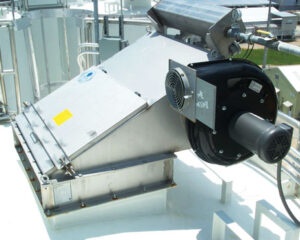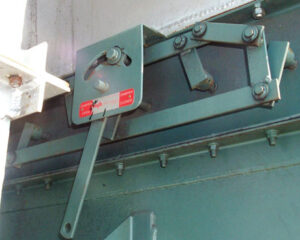Adjusting Dust Collector Fan Dampers to Save Time and Money
Fan damper adjustment could occur several times from when filters are new to when they have eventually come to the end of their useful service
By John Staskiewicz, Donaldson Torit Regional Engineer
Fan Damper Initial Setting

Initially when a dust collector is commissioned, the service technician will measure the total air volume and the duct conveying velocity; he will then assess proper dust control at the hoods in the process. Once the measurements have been completed, the technician will set and record the fan damper position.
The initial velocity measurements are usually performed when the system and the filters are new. Since the filters are fresh, there is no dust cake on them and the differential pressure is usually low – somewhere around 1.0 inch of water column.
Opening Dampers as Differential Pressure Increases
Most dust collectors have an automatic filter cleaning system that will purge the filters of excess dust to maintain an average differential pressure for filter efficiency. Cleaning the filters also serves to maintain air flow volumes and velocities for proper dust control at the process. Over time as the differential pressure increases, airflows can diminish, and it may be necessary to open the damper slightly to maintain adequate dust control. This damper adjustment could occur several times from when filters are new to when they have eventually come to the end of their useful service (Figure 1).
Resetting Damper Position at Filter Changeout

When the time comes to service the collector, operators will remove the used filters and install a new set. With the new filters installed, the damper must be returned from its current position and adjusted back down to its original position, which was set during the commissioning of the dust collector. If the damper is not adjusted back to the original position, the dust collector will have higher than designed airflows and air velocities. These higher air velocities can shorten filter life and cost the company additional money in terms of more frequent filter replacements, labor to replace filters and lost production time.
Considerations for Product Reclamation
Another reason to adjust the fan damper position is to prevent product loss. If the dust collector is on a process to control dust, it is not intended to pick up valuable product. If the damper was left open after a filter replacement, then valuable product may be inadvertently drawn into the collector due to increased airflow velocities. After the dust collector has been serviced with new filters, product loss can be controlled with a damper adjustment (Figure 2).
Summary
Bottom line: Mark the initial damper settings at commissioning or when airflows are measured with a new set of filters. If the fan damper is adjusted during the normal course of production, remember to return the damper back to the original settings when fresh filters are installed to prevent premature blinding, abrasion or product loss.

AST Canada has been helping clients find solutions for their unique Dust, Mist & Fume Collection needs for more than 40 years.
We can help you too.

